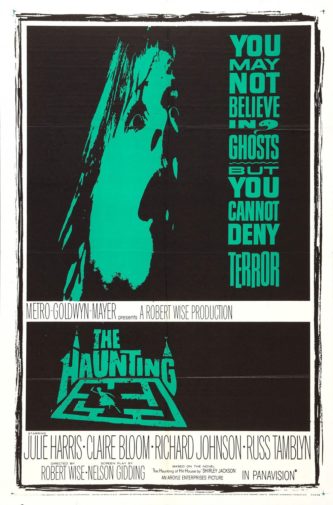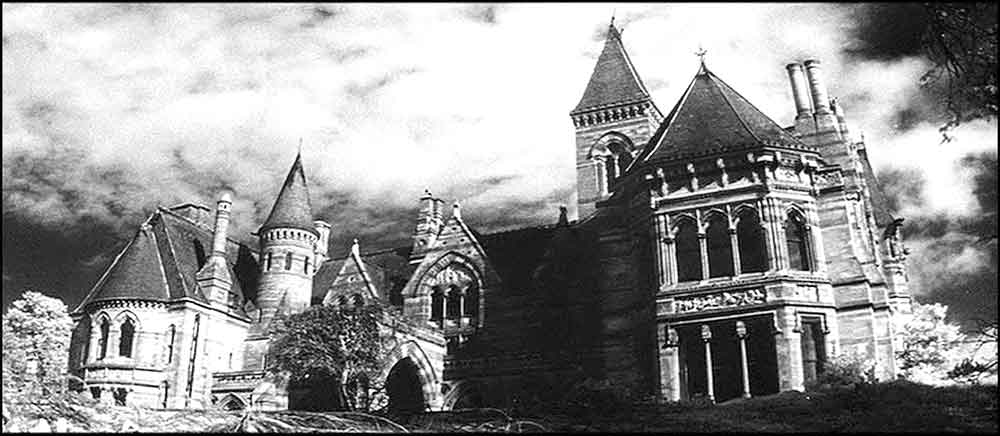 A G-rated horror movie? Yes, there is indeed such a thing, and it can actually work, as this 1963 classic from the late Robert Wise proves. If nothing else, the film deserves credit for hewing so closely to its source novel, Shirley Jackson’s THE HAUNTING OF HILL HOUSE.
A G-rated horror movie? Yes, there is indeed such a thing, and it can actually work, as this 1963 classic from the late Robert Wise proves. If nothing else, the film deserves credit for hewing so closely to its source novel, Shirley Jackson’s THE HAUNTING OF HILL HOUSE.
A G-rated horror movie? Yes, there is indeed such a thing, and it can actually work, as this 1963 classic from the late Robert Wise proves. I
THE HAUNTING is the premiere film advocated by those who argue in favor of “Quiet” horror, along with the cinema of Val Lewton (THE HAUNTING’S producer/director Robert Wise, FYI, got his start directing Lewton productions, including CURSE OF THE CAT PEOPLE and THE BODY SNATCHER). Those in the opposite camp also like to single out THE HAUNTING; Clive Barker, told by a journalist that the latter liked this film, responded “you like movies where nothing happens!” In short, THE HAUNTING, “quiet” or not, is one of the most controversial horror films in existence, and that’s to its credit.
This film was unfortunately remade in 1999 by producer Steven Spielberg and director Jan de Bont, who bastardized Shirley Jackson’s source novel unmercifully and fell into every trap this original HAUNTING avoids.
 A macabre experiment is devised by Dr. Montague, who wants to gather several psychically inclined folk inside Hill House, an apparently haunted abode cursed by decades of murder and madness. Only three people respond to his summons: the seductive lesbian Theodora, the impish Luke–who stands to inherit Hill House from his aunt–and the meek Eleanor. The film is told from the point of view of the latter, who has no friends, having spent a large portion of her short life caring for her ailing mother. She’s agreed to take part in Dr. Montague’s experiment to simply do something.
A macabre experiment is devised by Dr. Montague, who wants to gather several psychically inclined folk inside Hill House, an apparently haunted abode cursed by decades of murder and madness. Only three people respond to his summons: the seductive lesbian Theodora, the impish Luke–who stands to inherit Hill House from his aunt–and the meek Eleanor. The film is told from the point of view of the latter, who has no friends, having spent a large portion of her short life caring for her ailing mother. She’s agreed to take part in Dr. Montague’s experiment to simply do something.
THE HAUNTING, “quiet” or not, is one of the most controversial horror films in existence, and that’s to its credit.
Once ensconced in the cavernous Hill House our intrepid foursome are bombarded with loud booming sounds and chalk graffiti reading “HELP ELEANOR COME HOME.” This unnerves Eleanor especially, and she comes to feel that whatever is haunting the house is singling her out. Yet she actually finds herself coming to like the atmosphere of Hill House, and desires to become one with it. It seems she’ll get her wish upon driving off one night and finding that her actions may not be her own…
 Robert Wise was a fine, workmanlike director who sometimes rose beyond that level. This was one such occasion.
Robert Wise was a fine, workmanlike director who sometimes rose beyond that level. This was one such occasion.
Wise had an evident talent for horror, learned no doubt from working for Val Lewton. The visuals have a rich, expressionistic sheen, and the black-and-white widescreen compositions, lensed more often than not in low angle wide shots, would seem to be inspired by another of Robert Wise’s mentors: Orson Welles (for whom Wise edited CITIZEN KANE). The production design is equally impressive, with a baroque and imposing central location, created on a studio lot with exteriors shot at the sight of an actual English manor, that appears to have sprung directly from the pages of Shirley Jackson’s novel.
Yet contrary to what many of the film’s admirers might have you believe, it isn’t perfect. Quite a few hokey early 1960s conventions are unfortunately on display: overemphatic music, echoey voice-overs and a superfluous PSYCHO-esque final summation to fill in the narrative for slow viewers.
It’s an imminently watchable and entertaining film, and it accomplishes those things, unbelievably enough, without a single onscreen ghost or creature.
Of the performers, it’s the leading ladies who make the greatest impression, with Julie Harris as Eleanor essaying a marvelous nerdette and Claire Bloom quite alluring as the sexually ambiguous Theodora. As for the guys—specifically the refined Richard Johnson as the pious Dr. Montague and teen idol Russ Tamblyn as Luke—they exist as essentially window dressing.
The film hews quite closely to the events of Shirley Jackson’s novel (although all the outdoor sequences have been excised), down to the bleak and uncompromising ending. This makes for a scare fest of uncommon grace and sophistication, yet Wise adds something the novel didn’t have: a sense of fun. It’s an imminently watchable and entertaining film, and it accomplishes those things, unbelievably enough, without a single onscreen ghost or creature. You may not agree with Robert Wise’s ultra low-key approach, but it works.
Vital Statistics
THE HAUNTING
Metro-Goldwyn-Meyer
Director: Robert Wise
Producer: Robert Wise
Screenplay: Nelson Gidding
(Based on a novel by Shirley Jackson)
Cinematography: Davis Boulton
Editing: Ernest Walter
Cast: Julie Harris, Claire Bloom, Richard Johnson, Russ Tamblyn, Fay Compton, Rosalie Crutchley, Lois Maxwell, Valentine Dyall

